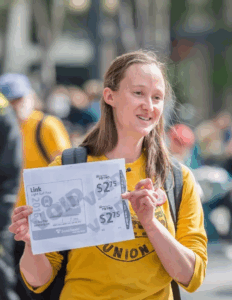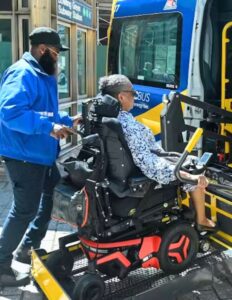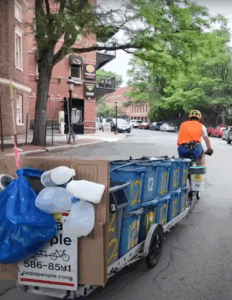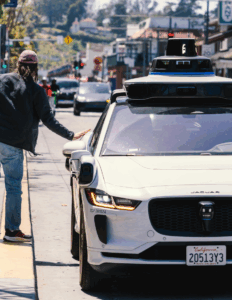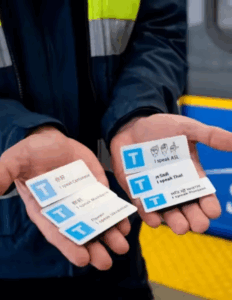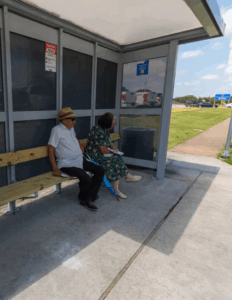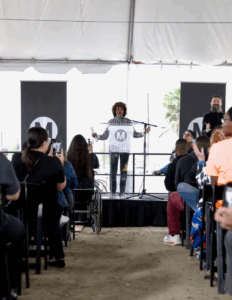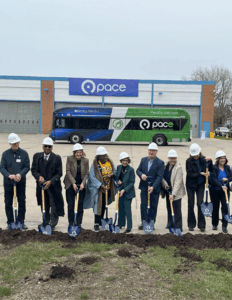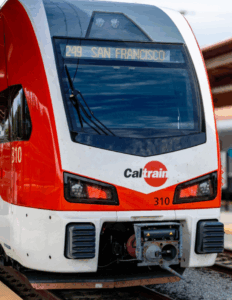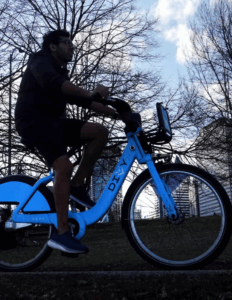What's New in Shared Mobility
5 minutes Date Launched/Enacted: Jul 8, 2025 Date Published: July 11, 2025

The Shared-Use Mobility Center (SUMC) has been tracking trends, developments, and news in the shared mobility industry. As we continue to explore innovations in technology and partnerships, increased interest in equity, growing enthusiasm for public transportation, and the diversification of modes that shared mobility brings to cities, we will use this page as a resource to track and highlight news and developments in the shared mobility space.
For a more in-depth analysis of trends in the shared mobility industry, see A Review of Shared Mobility in 2024.
Here are some of the most relevant recent shared mobility stories:
November 2025
November’s shared mobility developments underscored growing political support for transit through historic electoral victories and legislative action. Across the country, voters approved 84% of transit measures on the ballot, generating an estimated $11.7 billion in revenue, with major wins including Mecklenburg County’s $388 million annual funding increase for light rail and bus service and new transit authorities established in rural areas like Colorado’s Yampa Valley. In Seattle, Transit Riders Union co-founder Katie Wilson narrowly defeated incumbent Mayor Bruce Harrell after a nine-day vote count, running on progressive policies including the ORCA LIFT low-income fare program she helped design. In Illinois, the state legislature passed a $1.5 billion transit funding bill that will enable frequent service on more CTA bus routes, overnight trains, and the creation of a unified Northern Illinois Transit Authority to coordinate the region’s three separate transit agencies. In New York City, Zohran Mamdani won the mayoral race on a platform promising fare-free buses, housing near transit hubs, and elimination of parking requirements. These victories demonstrated strong grassroots support for transit investments even as federal transit funding faces uncertainty under the Trump administration.
October 2025
October’s shared mobility updates showed increasing investment in paratransit service improvements and cost reductions. In New York City and Albuquerque, RideCo partnered with transit agencies to deploy cloud-based software optimizing routing and scheduling for paratransit operations. In the Chicago suburb of Schaumburg, the township launched electric buses specifically serving older adults and people with disabilities. Colorado-based Via Mobility Services permanently eliminated all fares for its door-through-door paratransit services across six counties, where over 70% of riders earn less than $30,000 annually. In Portland, Oregon, TriMet’s partnership with Instacart provided nearly 300 paratransit riders with free grocery delivery memberships, saving the agency an estimated $350,000 in six months while improving access to fresh food and household essentials. These initiatives highlighted how enhancements like elimination, electrification, and expanded partnerships can help paratransit services meet equity and efficacy goals.
September 2025
September’s mobility stories highlighted the accelerating role of cargo bikes and zero-emission delivery in urban logistics. In Massachusetts, worker-owned cooperative Pedal People continued to prove that essential city services can operate entirely on pedal power, replacing diesel trucks with cargo bikes while creating local jobs. In India, Coca-Cola began integrating thousands of electric three-wheelers in cargo transportation, cutting emissions in densely populated neighborhoods. In Montreal, the YouTubers Oh the Urbanity! showcased three community-led programs—Mulo, Locomotion, and Bixi—lowering barriers to cargo bike use through shared equipment and local hosting. And in Portland, a six-month zero-emission delivery zone pilot spurred companies to expand e-cargo bike fleets. Collectively, these initiatives illustrate the growing popularity of human-scale, decarbonized cargo transportation across the globe.
August 2025
August’s shared mobility developments highlighted the potential of technology like AI in increasing transportation efficiency and accessibility. In Philadelphia and Los Angeles, transit agencies deployed AI-powered bus cameras that automatically ticket lane blockers, cutting delays by up to 36% and collisions by 34%. In New York City, Waymo received its first permit to begin testing AVs, launching up to eight vehicles in Manhattan and Downtown Brooklyn under new safety rules. BART’s introduction of credit and debit card tap payment technology at entry points, mirroring systems like London Underground, modernized payments and expanded access in the Bay Area. On the research side, German programmers developed an AI route planner that predicts shared bike and scooter availability, encouraging multimodal travel and reducing car use. Together these developments reveal the increasing value of new technology like AI in streamlining the efficiency, reliability and accessibility of existing transportation systems.
July 2025
July’s mobility stories highlighted the growing effectiveness of transit agencies’ targeted equity programs that address specific demographic and socioeconomic barriers. TransLink’s multilingual “hello” pin initiative demonstrated how cultural recognition can make systems more welcoming to non-English speaking communities, while Albuquerque’s zero-fare program provided essential transportation access for residents needing rides for work and medical care. Similarly, Baltimore’s Montgomery County made nearly 100 local bus routes free to support low-income residents and reduce traffic congestion. GoGoGrandparent’s subsidized ride program connected nearly 14,000 seniors to on-demand transport in the Bay Area, growing 450% in Oakland alone. These initiatives reflect clear strengths in precision-targeted interventions that address the distinct mobility challenges faced by vulnerable populations.
June 2025
June’s shared mobility updates highlighted important progress in the Southwest, tackling less conventional accessibility challenges through people-focused infrastructure. Houston Metro piloted new bus shelters designed with perforated panels to reduce extreme heat at stops, addressing shade equity and climate-related health risks. Nearby, San Antonio is introducing two rapid bus lines—Green and Silver—to enhance the city’s lacking public transit at lower costs. Los Angeles launched a major effort to install 3,000 modern bus shelters, improving rider safety and comfort while providing real-time transit info. Utilizing UCLA’s shade-mapping technology, American Forrests released an urban heat disparities map in hopes to help cities like Austin and Phoenix plan tree plantings to improve shade and cooling. These stories reveal a major trend in the Southwest of communities strengthening bus transit and responding to extreme heat by prioritizing environmental comfort and safety alongside traditional transit needs.
May 2025
May’s shared mobility news spotlighted bold local and regional actions aimed at making transportation more accessible for all residents, regardless of barriers like disability and cost. In South Central Los Angeles, the grand opening of the long-anticipated $166 million Rail-to-Rail Active Transportation Corridor created a 5.5-mile link to parks, schools, and transit stations, delivering safe, community-driven infrastructure where it’s long been needed. Meanwhile, Putnam County, New York, partnered with Via to launch Putnam On-Demand, a $2.50 ride-hailing service featuring wheelchair accessibility and app-based convenience for rural and suburban riders. California’s revived e-bike voucher program, offering up to $2,000 for low-income residents, advanced clean mobility access while supporting local economies. New Haven, Connecticut, prepared to launch 300 electric scooters from Veo, offering free rides for eligible residents in areas like Downtown New Haven. These projects showed how targeted investments in infrastructure, micromobility, and first/last-mile services are aiding underserved communities and combatting barriers in both financial and spatial accessibility.
April 2025
April’s mobility updates reflected a clear reaffirmation of climate goals in shared mobility as advocates responded to major funding challenges. Following news that federal support for bike lanes had halted, California, Illinois, and New York joined forces to launch the Clean Rides Network, a multistate coalition pushing forward their own sustainable mobility agendas. In Cleveland, Mayor Justin Bibb announced the Cleveland Moves initiative, the city’s first comprehensive transportation plan in nearly two decades, which commits to 50 miles of protected bike lanes and includes a Vision Zero strategy. Meanwhile, the Phoenix light rail extension prepared for its June opening, adding 5.5 miles of track, improving bike infrastructure, and promising daily ridership growth in underserved neighborhoods. And in Illinois, Pace Suburban Bus began construction on an all-electric bus garage in line with the state’s climate goals. These stories show how cities and states are continuing to break ground on low-emission, multimodal futures, often with a renewed sense of urgency and local leadership in the absence of consistent federal support.
March 2025
March saw public agencies across the globe take bold steps to modernize shared transportation systems through historic investments and infrastructure upgrades. In California, Assemblymember Nick Shultz advanced AB 939, a proposed $20 billion bond measure that would fund zero-emission transit, sustainable rail, and clean vehicle projects statewide. In New York City, e-scooter ridership surged 79% in February alone, prompting Lime to commit $10 million—and another $8 million annually—to improve safety, operations, and parking compliance. Meanwhile, the Orange County Transportation Authority placed the largest U.S. order of hydrogen-powered buses to date— supported by federal and local funding—marking a major step toward a cleaner fleet. And in Houston, the launch of the $9.4 million METRONow initiative introduced hundreds of new buses, investments in homelessness response, and a renewed focus on rider experience. Together, these efforts demonstrate how agencies are responding to shifting travel patterns, climate imperatives, and equity goals by retooling legacy systems.
February 2025
February’s shared mobility highlights underscored how community-driven policy and infrastructure investments are reshaping mobility access and public spaces. Boston’s MBTA partnered with the city to pilot traffic signal upgrades on Brighton Avenue, improving bus reliability and cutting delays by 21%—a step toward more responsive, efficient transit. Meanwhile, grassroots activism continues to prove its power: the People Protected Bike Lanes movement, launched in 2017, has led to protected bike infrastructure in 58% of its protest locations, according to an NYU study. In Chicago, shared bike and scooter usage climbed 26% in 2024, spurring plans to expand the Divvy system with 400 new stations. In Washington D.C., disability advocates supported a new transit navigation app launched for the visually impaired, offering audio instructions and reliable navigation using smartphone sensors. These highlights revealed how local advocacy and targeted public investment are coming together to create more resilient, inclusive transportation networks.
January 2025
January’s shared mobility developments highlighted a growing emphasis on cost reduction, innovation, and accessibility in urban mobility. New York’s congestion pricing initiative showed tangible benefits early on, with reduced traffic and increased subway ridership, though it continued to face persistent political challenges. Meanwhile, the celebration of Transit Equity Day through free rides across the country underscored the importance of accessible public transit and affordable programs targeted at underserved communities. In Houston, the Metropolitan Transit Authority piloted a microtransit program that used app-based EVs to bridge “first and last mile” gaps, showcasing how technology could enhance connectivity in underserved areas. Simultaneously, California’s E-Bike Incentive Project advanced zero-emission transportation by providing safety training and financial vouchers, prioritizing low-income residents to ensure equitable access to sustainable mobility. Together, these initiatives reflected a broader trend of cities leveraging partnerships and technology to create more inclusive and less cost-burdened transportation options.
